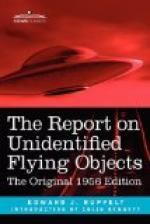When the story broke in other papers, the colonel’s affiliation with civil defense wasn’t mentioned, and he became merely “a colonel from Dayton.” Dayton was quickly construed by the public to mean Wright-Patterson AFB and specifically ATIC. Some people in the Pentagon screamed while others gleefully clapped their hands. The gleeful handclaps were from those people who wanted the UFO’s to be socially recognized, and they believed that if they couldn’t talk their ideas into being they might be able to force them in with the help of this type of publicity.
The temporary lull in reporting that Project Blue Book had experienced in early July proved to be only the calm before the storm. By mid-July we were getting about twenty reports a day plus frantic calls from intelligence officers all over the United States as every Air Force installation in the U.S. was being swamped with reports. We told the intelligence officers to send in the ones that sounded the best.
The build-up in UFO reports wasn’t limited to the United States— every day we would receive reports from our air attaches in other countries. England and France led the field, with the South American countries running a close third. Needless to say, we didn’t investigate or evaluate foreign reports because we had our hands full right at home.
Most of us were putting in fourteen hours a day, six days a week. It wasn’t at all uncommon for Lieutenant Andy Flues, Bob Olsson, or Kerry Rothstien, my investigators, to get their sleep on an airliner going out or coming back from an investigation. TWA airliners out of Dayton were more like home than home. But we hadn’t seen anything yet.
All the reports that were coming in were good ones, ones with no answers. Unknowns were running about 40 percent. Rumors persist that in mid-July 1952 the Air Force was braced for an expected invasion by flying saucers. Had these rumormongers been at ATIC in mid-July they would have thought that the invasion was already in full swing. And they would have thought that one of the beachheads for the invasion was Patrick AFB, the Air Force’s Guided Missile Long-Range Proving Ground on the east coast of Florida.
On the night of July 18, at ten forty-five, two officers were standing in front of base operations at Patrick when they noticed a light at about a 45-degree angle from the horizon and off to the west. It was an amber color and “quite a bit brighter than a star.” Both officers had heard flying saucer stories, and both thought the light was a balloon. But, to be comedians, they called to several more officers and airmen inside the operations office and told them to come out and “see the flying saucer.” The people came out and looked. A few were surprised and took the mysterious light seriously, at the expense of considerable laughter from the rest of the group. The discussion about the light grew livelier and bets that it was a balloon were placed. In the meantime




